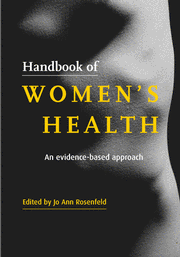Book contents
- Frontmatter
- Contents
- List of contributors
- Common abbreviations used in the text
- Normal blood values in women and during pregnancy
- Introduction
- 1 Singular health care of women
- Preventive care
- Psychosocial health
- Sexuality
- Genitourinary medicine
- Breast disorders
- Psychological disorders
- Common medical problems
- Index
Introduction
Published online by Cambridge University Press: 28 October 2009
- Frontmatter
- Contents
- List of contributors
- Common abbreviations used in the text
- Normal blood values in women and during pregnancy
- Introduction
- 1 Singular health care of women
- Preventive care
- Psychosocial health
- Sexuality
- Genitourinary medicine
- Breast disorders
- Psychological disorders
- Common medical problems
- Index
Summary
The purpose of this book is to consider the woman and her health needs in her position in her life cycle, her family, and society. Women have historically been “the other” in medical care. Sigmund Freud and Erik Erikson considered women's development to be deviant from the normal, which was men's. Although the Greeks Hippocrates and Soranus wrote about women's medical needs, women's health concerns have either been considered abnormal, or, traditionally, been condensed to their gynecological functions and disorders, perhaps because these were their only valued functions. Since the 1860s and the organization of medicine, women's health and those who provided for it were usually considered one of the least important parts of medicine. In the past 20 to 40 years, women's health concerns have begun to take their place as topics worthy of discussion.
Recognizing that combining “all women” into any classification is fraught with difficulties, this book attempts to distinguish and point out the differences and individualities of women. Women are more likely to be different than all alike, and must be treated as individuals.
Because much of clinical experience and research does not separate or study women independently, this book examines the strength and depth of evidence, using clinical experience and data discovered on studies on women, when available, and on men, when research on women is lacking. Thus, at times, deciding on the best way to help the woman manage health concerns may be difficult.
- Type
- Chapter
- Information
- Handbook of Women's HealthAn Evidence-Based Approach, pp. 1Publisher: Cambridge University PressPrint publication year: 2001

